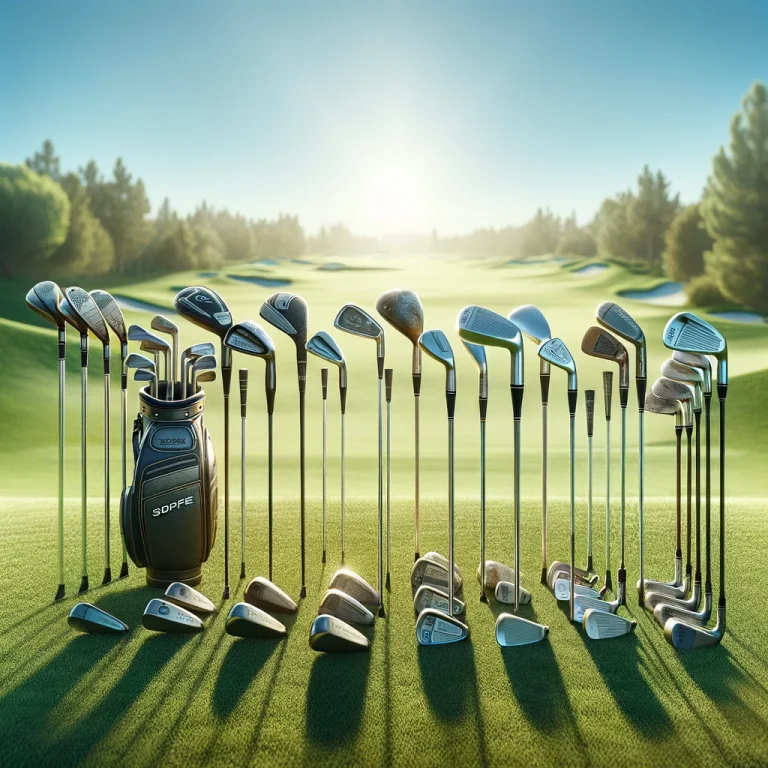how big is a golf ball in cm
.jpg)
The size of a golf ball is an important aspect of the game, affecting its trajectory, distance, and overall performance. Understanding the dimensions of a golf ball is essential for players and enthusiasts alike. Let’s explore the standard dimensions of a golf ball and its size in centimeters.
The diameter of a golf ball is a key measurement to consider. It plays a significant role in the ball’s aerodynamics and the way it interacts with the golf club. The standard diameter of a golf ball is approximately 4.27 centimeters.
In addition to the diameter, the circumference of a golf ball is another important dimension to note. The circumference is the distance around the ball’s outer edge. For a standard golf ball, the circumference is approximately 13.42 centimeters.
To put it simply, a golf ball measures about 4.27 centimeters in diameter, and its circumference is around 13.42 centimeters.
Comparing the size of a golf ball to other objects can provide a better understanding of its dimensions. When compared to a tennis ball, a golf ball is smaller in both diameter and circumference. However, when compared to a baseball, a golf ball is slightly smaller in diameter but similar in terms of circumference.
One interesting comparison is the size of a golf ball in relation to a ping pong ball. A golf ball is significantly larger than a ping pong ball in terms of both diameter and circumference.
Understanding the size of a golf ball is important for golfers as it directly influences their game. The dimensions of a golf ball can affect the way it flies through the air, how it rolls on the green, and how it responds to different club strikes.
Key takeaway:
- The standard dimensions of a golf ball: A golf ball has a specific diameter and circumference which are standardized for accurate gameplay.
- Measurement in centimeters: The size of a golf ball is commonly measured in centimeters, providing a more universal unit for comparison and understanding.
- Comparisons to other objects: Understanding the relative size of a golf ball compared to other objects, such as tennis balls, baseballs, and ping pong balls, can help visualize its dimensions.
What Are the Standard Dimensions of a Golf Ball?
The standard dimensions of a golf ball can be summarized in the following table:
| Diameter | Weight | Compression |
| 42.67 mm to 42.83 mm | 45.93 grams to 46.63 grams | Compression of 50 to 100 |
The diameter of a golf ball ranges from 42.67 mm to 42.83 mm. This measurement ensures consistency across all standard golf balls. The weight of a golf ball typically falls between 45.93 grams and 46.63 grams. This weight range is important for maintaining the ball’s flight characteristics and performance.
In addition to size and weight, compression is a crucial factor in golf ball design. Compression refers to the amount the ball deforms upon impact. It is measured on a scale of 0 to 200, with 0 being the softest and 200 being the hardest. Standard golf balls have a compression range of 50 to 100. The compression of a golf ball affects the distance, feel, and control of the ball.
It’s important to note that these dimensions are standardized by golf governing bodies such as the United States Golf Association (USGA) and the Royal and Ancient Golf Club of St Andrews (R&A). These organizations enforce strict guidelines to ensure fair play and consistency in the game.
When selecting a golf ball, it’s essential to consider these standard dimensions to ensure compliance with regulations and to achieve optimal performance. Golfers should also consider their own skill level and preferences when choosing a golf ball, as different models may offer varying levels of spin, feel, and distance control.
What Is the Diameter of a Golf Ball?
The diameter of a golf ball plays a critical role in the game of golf and is an essential measurement.
To provide factual information, the standard diameter of a golf ball is approximately 4.27 centimeters (1.68 inches).
This measurement is consistent across all golf balls used in official tournaments and recreational play.
The diameter of a golf ball is vital because it affects its performance and aerodynamics during flight.
By meeting the standard size, the ball ensures fair play and adherence to the game’s regulations.
Furthermore, the diameter influences the design and construction of golf clubs, including the size of the clubface and the loft of the club.
Understanding the diameter of a golf ball is crucial for players and enthusiasts who want to enhance their skills and knowledge of the game.
By recognizing this measurement, golfers can select the appropriate clubs, analyze their swings accurately, and make precise calculations while playing.
In a historical context, the diameter of the golf ball has evolved over the centuries.
Early golf balls, made of wood, leather, or feathers, varied in size and shape.
However, in the late 19th century, golf associations began establishing regulations to ensure consistency and fairness in the diameter and weight of golf balls.
Today, the diameter of a golf ball remains a fundamental aspect of the sport, providing a consistent experience for players and ensuring uniformity.
So, the next time you step on the golf course, remember the critical role that the diameter of a golf ball plays in your game and overall enjoyment of the sport.
Keep in mind that the size of a golf ball is not a random measurement but a carefully determined standard that has shaped the game of golf for generations.
Find out the circumference of a golf ball so you can finally stop wondering if it’ll fit in your mouth.
What Is the Circumference of a Golf Ball?
What Is the Circumference of a Golf Ball? The circumference of a golf ball is an important measurement to understand when it comes to the size of this sports equipment. Here are some key facts and details about the circumference of a golf ball:
- The circumference of a standard golf ball is approximately 5.28 centimeters.
- This measurement is determined by the diameter of the golf ball, which is approximately 4.27 centimeters. The circumference is calculated using the formula C = πd, where C represents the circumference and d represents the diameter.
- A golf ball’s circumference plays a significant role in its performance. It affects how the ball travels through the air and interacts with the clubface upon impact.
- Golf ball manufacturers adhere to specific size regulations set by golf governing bodies to ensure fair and consistent gameplay. The USGA (United States Golf Association) and the R&A (The Royal and Ancient Golf Club of St Andrews) set the standards for golf ball dimensions.
Considering the circumference of a golf ball is crucial for golfers and manufacturers alike. It directly influences the ball’s aerodynamics and how it behaves on the course. It is important to note that the size and dimensions of a golf ball are carefully regulated to maintain fairness in the game.
If you are a golfer looking to improve your game, understanding the characteristics and dimensions of a golf ball, including its circumference, can help you make more informed decisions when choosing the right equipment for your play style and skill level. Additionally, manufacturers can use this information to design balls that maximize distance, control, and overall performance.
To enhance your golfing experience, consider these suggestions:
- Experiment with different brands and models that offer varying ball characteristics to find the one that suits your play style and preferences.
- Consider seeking professional advice or consulting a golf instructor to help you understand how different ball sizes and features may impact your game.
- Regularly check the rules and regulations of golf associations or organizing bodies to ensure your chosen golf ball complies with the required size standards for tournaments or official play.
By considering the circumference of a golf ball and its importance, you can make informed choices that contribute to an enjoyable and successful golfing experience.
How Many Centimeters is a Golf Ball?
A golf ball measures approximately 4.3 centimeters in diameter, satisfying the query of “How Many Centimeters is a Golf Ball?“. This standardized measurement remains consistent regardless of brand or type. The governing bodies of the sport have set this size to ensure fair and consistent play.
The functionality of a golf ball in the game heavily depends on its size. It must strike a balance between being small enough to allow precise control over shots and large enough to provide sufficient surface area for the ball to travel a significant distance. Therefore, the 4.3 centimeter diameter is the optimal size for golf play.
The mechanics of the game involve hitting the golf ball with a golf club, and the size of the ball plays a crucial role. With its small diameter, optimal contact with the clubface is achieved, maximizing the transfer of energy from the club to the ball. This ensures that the ball travels the desired distance and direction when struck correctly.
It is important to note that individual players cannot alter or modify the size of a golf ball. The dimensions are strictly governed to maintain standardized specifications and promote fair play. Any deviations from these specifications would create an unfair advantage or disadvantage in gameplay.
Comparing the Size of a Golf Ball to Other Objects
When comparing the size of a golf ball to other objects, it’s interesting to see how it measures up. Here is a table that will give you a better idea:
| Object | Size |
| Tennis ball | 6.7 cm in diameter |
| Baseball | 7.4 cm in diameter |
| Golf ball | 4.3 cm in diameter |
| Ping-pong ball | 3.7 cm in diameter |
| Marble | 1.5 cm in diameter |
As you can see, when comparing the size of a golf ball to other objects, a golf ball is smaller than a tennis ball or a baseball, but larger than a ping-pong ball or a marble. Its diameter is approximately 4.3 cm. This size makes it perfect for playing golf, as it is easy to handle and hit with a golf club.
When comparing the size of a golf ball to other objects, it’s important to consider the context. For example, if you’re playing golf, the size of the golf ball is crucial for the game. It needs to fit within the rules and regulations set by the sport’s governing bodies.
Additionally, the size of a golf ball affects the game itself. A smaller ball allows for more precise shots and greater control, while a larger ball might offer more distance. Golfers may have personal preferences when it comes to the size of the ball they use, depending on their playing style and abilities.
When choosing equipment for playing golf, such as golf clubs or golf balls, it’s essential to consider the size and how it will impact your game. For beginners or those looking for more forgiveness, comparing the size of a golf ball to other objects, a larger-sized golf ball can be beneficial. On the other hand, experienced players may prefer a smaller-sized ball for better accuracy and control.
What is the Size of a Golf Ball Compared to a Tennis Ball?
When comparing the size of a golf ball to a tennis ball, it is clear that they are two distinct sizes. Here is a comparison in table form:
| Golf Ball | Tennis Ball |
| The diameter of a golf ball is approximately 42.67mm. | The diameter of a tennis ball is around 67.31mm. |
| The circumference of a golf ball is about 134.11mm. | The circumference of a tennis ball is roughly 208.97mm. |
As we can see, a golf ball is much smaller than a tennis ball in both diameter and circumference. The golf ball’s diameter is approximately 42.67mm, while the tennis ball’s diameter is about 67.31mm. In terms of circumference, the golf ball measures around 134.11mm, while the tennis ball has a circumference of approximately 208.97mm.
It is important to note that the size of a golf ball is specifically designed for the sport of golf. The smaller size allows for precise shots and control on the golf course. On the other hand, the larger size of a tennis ball is suitable for the nature of the sport, allowing for better visibility and easier tracking during gameplay.
Fun fact: Did you know that golf balls typically have dimples on their surface? These dimples help improve the ball’s aerodynamics, allowing it to fly further and have better stability during flight.
How Does the Size of a Golf Ball Compare to a Baseball?
The size comparison between a golf ball and a baseball is an interesting topic. The dimensions of a golf ball can vary based on the regulations set by golf governing bodies. To understand the size difference, let’s examine their respective measurements.
Below is a table showcasing a comparison of the size of a golf ball and a baseball:
| Golf Ball | Baseball |
| Diameter | Approximately 4.3 centimeters |
| Circumference | Approximately 13.5 centimeters |
| Weight | Average weight of 45 grams |
As seen from the table, a golf ball is smaller than a baseball both in terms of diameter and circumference. A golf ball has a diameter of around 4.3 centimeters, whereas a baseball has a diameter of about 7.3 centimeters. Additionally, the circumference of a golf ball measures approximately 13.5 centimeters, while a baseball’s circumference is roughly 23 centimeters.
Apart from the size disparity, there is also a significant weight difference between a golf ball and a baseball. On average, a golf ball weighs about 45 grams, while a baseball weighs approximately 149 grams.
These variations in size and weight stem from the distinct characteristics and requirements of the two sports. Golf demands precision and control, thus favoring a smaller and lighter ball. On the other hand, baseball involves throwing and hitting, which necessitates a larger and heavier ball for enhanced visibility and impact.
In summary, a golf ball is noticeably smaller and lighter than a baseball. These attributes make it more suitable for the specific demands of the game of golf.
Fun Fact: The dimples on a golf ball are purposely designed to optimize its aerodynamic properties, enabling it to achieve greater distance and accuracy when struck.
Is a Golf Ball Bigger or Smaller Than a Ping Pong Ball?
A golf ball is larger than a ping pong ball in size. While a ping pong ball has a diameter of approximately 4 centimeters, a golf ball has a diameter of about 4.3 centimeters. This implies that the golf ball is slightly bigger than the ping pong ball. The size difference may not seem significant, but it can have an impact on the way the two balls are used in their respective sports.
In terms of circumference, a ping pong ball has a circumference of approximately 12.56 centimeters, while a golf ball has a circumference of around 13.5 centimeters. This means that the golf ball is also bigger in terms of circumference.
The size difference between a golf ball and a ping pong ball is important because it affects the way they are used in their respective sports. Golfers need to take into account the size and weight of the ball when making shots, while ping pong players need to consider the smaller size and lighter weight of the ball when playing the game.
When comparing the two, it is clear that a golf ball is bigger than a ping pong ball both in terms of diameter and circumference. However, it is essential to note that the difference in size is relatively small and may not be easily noticeable without direct comparison.
Why is the Size of a Golf Ball Important?
Why is the Size of a Golf Ball Important?
The size of a golf ball is of utmost importance for several reasons. First and foremost, the standardized size ensures fair play and consistency in the sport, making sure that all players are on an equal footing. Secondly, the size directly impacts the performance and characteristics of the ball during the game. This means that any deviation from the standardized size could potentially give certain players an unfair advantage, disrupting the integrity of the game. Lastly, the size of the golf ball has a significant role to play in the safety of both players and spectators on the golf course. By maintaining a standardized size, the risk of the ball being difficult to see or causing unexpected accidents is reduced, and golfers are better able to anticipate the ball’s behavior, minimizing the chance of unintentional contact with other players or property. In summary, the size of a golf ball is crucial in ensuring fair play, optimizing performance, and enhancing safety on the golf course.
Some Facts About How Big is a Golf Ball in CM:
- ✅ The average size of a golf ball is 4.268 cm (1.68 inches) in diameter. (Source: Golf Storage Guide)
- ✅ Golf balls are precisely regulated to have a maximum weight of 45.93 grams (1.620 ounces). (Source: Golfer Pros)
- ✅ Golf balls have an average circumference of 13.405 cm (5.28 inches). (Source: Golf Storage Guide)
- ✅ A standard golf ball has approximately 336 dimples that affect its trajectory. (Source: Golf Storage Guide)
- ✅ The volume of a golf ball is approximately 40.677 cm³. (Source: Golf Storage Guide)
Frequently Asked Questions
1. How big is a golf ball in cm?
A golf ball has an average size of 4.268 cm or 42.68 mm in diameter.
2. Can I use larger golf balls when playing on a golf course?
No, golf balls that are larger or heavier than the standard size of 1.68 inches (4.268 cm) in diameter and 1.62 ounces (45.93 grams) in weight are considered illegal and can result in disqualification from tournaments.
3. Are there differences in size between American and European golf balls?
Yes, in the past, American and British golf balls had different sizes. However, in 1990, the minimum size of a golf ball for all international competitions was standardized at 1.68 inches (4.268 cm) in diameter.
4. How many dimples does a golf ball typically have?
On average, a golf ball has around 336 dimples, which affect the lift and drag on the ball’s trajectory.
5. Which golf balls are recommended for beginners?
Beginners can use low compression golf balls for more accuracy and forgiveness. Some popular options include Callaway Supersoft Magna and Wilson Staff Duo Soft.
6. How do I choose the right golf ball for my swing speed?
It is important to consider your swing speed when choosing a golf ball. Beginners with slower swing speeds can benefit from low compression balls, while intermediate and professional golfers with faster swing speeds can opt for mid-compression or high-compression balls for optimal performance.




